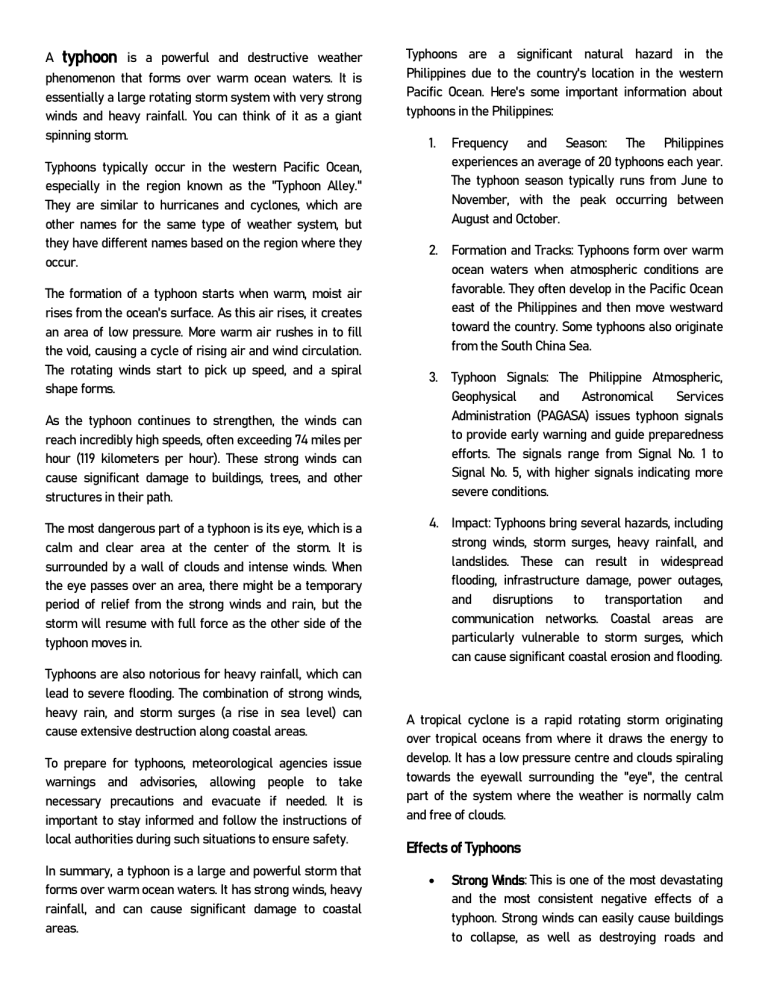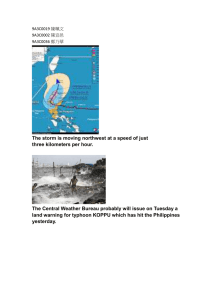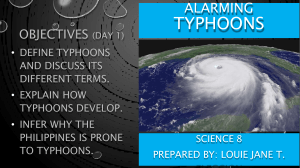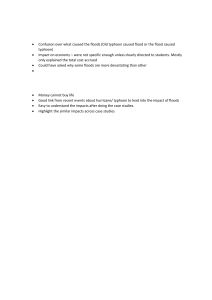
A typhoon is a powerful and destructive weather phenomenon that forms over warm ocean waters. It is essentially a large rotating storm system with very strong winds and heavy rainfall. You can think of it as a giant spinning storm. Typhoons typically occur in the western Pacific Ocean, especially in the region known as the "Typhoon Alley." They are similar to hurricanes and cyclones, which are other names for the same type of weather system, but they have different names based on the region where they occur. The formation of a typhoon starts when warm, moist air rises from the ocean's surface. As this air rises, it creates an area of low pressure. More warm air rushes in to fill the void, causing a cycle of rising air and wind circulation. The rotating winds start to pick up speed, and a spiral shape forms. As the typhoon continues to strengthen, the winds can reach incredibly high speeds, often exceeding 74 miles per hour (119 kilometers per hour). These strong winds can cause significant damage to buildings, trees, and other structures in their path. The most dangerous part of a typhoon is its eye, which is a calm and clear area at the center of the storm. It is surrounded by a wall of clouds and intense winds. When the eye passes over an area, there might be a temporary period of relief from the strong winds and rain, but the storm will resume with full force as the other side of the typhoon moves in. Typhoons are also notorious for heavy rainfall, which can lead to severe flooding. The combination of strong winds, heavy rain, and storm surges (a rise in sea level) can cause extensive destruction along coastal areas. To prepare for typhoons, meteorological agencies issue warnings and advisories, allowing people to take necessary precautions and evacuate if needed. It is important to stay informed and follow the instructions of local authorities during such situations to ensure safety. In summary, a typhoon is a large and powerful storm that forms over warm ocean waters. It has strong winds, heavy rainfall, and can cause significant damage to coastal areas. Typhoons are a significant natural hazard in the Philippines due to the country's location in the western Pacific Ocean. Here's some important information about typhoons in the Philippines: 1. Frequency and Season: The Philippines experiences an average of 20 typhoons each year. The typhoon season typically runs from June to November, with the peak occurring between August and October. 2. Formation and Tracks: Typhoons form over warm ocean waters when atmospheric conditions are favorable. They often develop in the Pacific Ocean east of the Philippines and then move westward toward the country. Some typhoons also originate from the South China Sea. 3. Typhoon Signals: The Philippine Atmospheric, Geophysical and Astronomical Services Administration (PAGASA) issues typhoon signals to provide early warning and guide preparedness efforts. The signals range from Signal No. 1 to Signal No. 5, with higher signals indicating more severe conditions. 4. Impact: Typhoons bring several hazards, including strong winds, storm surges, heavy rainfall, and landslides. These can result in widespread flooding, infrastructure damage, power outages, and disruptions to transportation and communication networks. Coastal areas are particularly vulnerable to storm surges, which can cause significant coastal erosion and flooding. A tropical cyclone is a rapid rotating storm originating over tropical oceans from where it draws the energy to develop. It has a low pressure centre and clouds spiraling towards the eyewall surrounding the "eye", the central part of the system where the weather is normally calm and free of clouds. Effects of Typhoons Strong Winds: This is one of the most devastating and the most consistent negative effects of a typhoon. Strong winds can easily cause buildings to collapse, as well as destroying roads and infrastructure. Strong winds could also damage agriculture by blowing away seeds and plants, making the crops unable to grow. Heavy Rainfall: Typhoons often bring intense rainfall, leading to flash floods and long-term flooding. This could cause flooding, the damaging of crops and homes, disrupt transportation, and many more. Storm Surge: Typhoons generate storm surges, which are a rising of the sea as a result of atmospheric pressure changes and wind associated with a storm. Storm surges can lead to coastal erosion, and the breaching of coastal defenses, putting coastal communities at risk of flooding and damage. Landslides: Landslides are caused by the precipitation that is present when a typhoon hits an area. Landslides occur when large amounts of water has settled on mountain tops. The intense pressure of the water pressing down, causes soil and rock to slide off from where they were. Landslides can damage infrastructure, block roads and rivers, and pose a threat to lives and property. Disruption of Services: Typhoons can disrupt essential services such as electricity, water supply, transportation, and communication networks. Power outages and damage to infrastructure can result in prolonged periods without access to basic necessities, making rescue and relief efforts challenging. Human Impact: Typhoons can cause injuries and loss of life due to collapsing structures, flying debris, flooding, landslides, and other hazards associated with the storm. The impact on human populations can be severe, requiring evacuations, emergency response, and medical assistance. Economic Consequences: The destruction caused by typhoons can have significant economic consequences. Damage to infrastructure, agriculture, businesses, and homes can lead to substantial financial losses. Recognize signs of impending Tphoon Weather Forecasts: Stay updated with local weather forecasts from reliable sources such as meteorological agencies, national weather services, or reputable weather websites. These forecasts often provide early warnings and track the development and movement of tropical cyclones, including typhoons. The very first signs the ting on our messages. So if you didnt notice then why the hell do you even have a phone for. For more details this will be further explained by ms. Tañamor Atmospheric Changes: Observe changes in the atmosphere that may indicate the approach of a typhoon. These can include: Increasing cloud cover: Notice an increase in the number and thickness of clouds, particularly dark, towering clouds associated with thunderstorms. It could be said that the clouds are threatening to rain till kingdom come. Changing wind patterns: Pay attention to sudden shifts in wind direction and increasing wind speeds. Normally we wouldn't notice this because we live in a somewhat urban area bit if you live in mountainous area you might if you like to travel Drop in atmospheric pressure: Monitor barometric pressure readings, as a significant drop may indicate the approach of a storm system. But mostly it's just rain and then it will stop only for it to rain again. Sea Conditions: Keep an eye on the conditions of the sea, especially if you live in a coastal area. Some signs of an impending typhoon include: Rising sea levels: Monitor tide levels and observe if there is a sudden increase in the water level along the coast, which could indicate an approaching storm surge. Since i'm no expert i would just think today's a high tide, so just avoid the coast Increasing wave activity: Notice if waves become higher and more powerful than usual, with increased frequency and intensity. As I said before it just look like a high tide Prepare an emergency kit: Gather essential supplies such as non-perishable food, drinking water,batteries, flashlights ( incase mo power outages) , a first aid kit, medications, and a portable radio. Include necessary documents, cash, and important contact numbers. Stay indoors: Avoid going outside during the typhoon unless it is absolutely necessary. Strong winds and flying debris pose significant risks. If you must venture outside, take extreme caution. Disconnect electrical appliances: Unplug all unnecessary electrical equipment to prevent damage from power surges. Avoid using electrical devices during the storm. Stay away from flood-prone areas: Avoid areas prone to flooding, such as low-lying regions, rivers, and streams. Be cautious of flash floods, which can occur rapidly and without warning. Sky Appearance: Look to the sky for visual cues that may suggest an approaching typhoon: Unusual cloud formations: Pay attention to the appearance of rotating or spiraling cloud formations, which can indicate the presence of a developing typhoon. You would notice this if most of us bothered to look up and not to our phones so yea Changes in sky color: Observe if the sky takes on a reddish or unusually dark appearance, which can be associated with the presence of a typhoon. Or here in dgte. It's just gray or black Animal Behavior: Sometimes, animals can exhibit changes in behavior that may signal an approaching storm: Birds: Watch for changes in bird activity. Birds may fly in larger flocks, lower to the ground, or exhibit signs of restlessness or agitation before a typhoon. Like every rain season Marine life: Notice if marine animals, such as fish, dolphins, or whales, move closer to shore or display unusual behavior patterns. That is if you live in coastal areas Local Warnings and Alerts: Stay tuned to official announcements, local news outlets, and emergency management agencies for any typhoon warnings, watches, or advisories specific to your area. These sources will provide timely information and instructions on how to prepare and stay safe. As I said before its on our messages with a phone number of Before a Typhoon: Create an emergency kit: Prepare an emergency kit that includes essential supplies such as nonperishable food, drinking water, medications, first aid supplies, battery-operated devices, important documents, and cash. Have enough supplies to last for several days. Secure your home: Inspect and reinforce your home for potential vulnerabilities. Trim tree branches that could fall on structures, reinforce doors and windows, and clear gutters and drains. Develop an evacuation plan: If you live in a floodprone or coastal area, identify evacuation routes and plan where you will go if you need to evacuate. Share the plan with your family members and establish a communication method to stay in touch. Secure your property: Before the typhoon hits, secure or bring inside any objects that can be easily blown away or cause damage, such as patio furniture, gardening tools, and outdoor equipment. Reinforce doors and windows if possible. 4. What to do before, during, and after the hydrometeorological hazard assigned During a Typhoon: Stay informed: Pay attention to weather reports, typhoon warnings, and updates from local authorities. Stay tuned to news broadcasts for the latest information. Local authorities issue evacuation orders. Secure important documents: Keep important documents like identification papers, insurance policies, and medical records in a waterproof and easily accessible place. Consider creating digital copies as well. What are the available tools for monitoring a Typhoon Meteorological Agencies: National meteorological agencies, such as the Japan Meteorological Agency (JMA), the Philippine Atmospheric, Geophysical, and Astronomical Services Administration (PAGASA), and the China Meteorological Administration (CMA), provide official typhoon monitoring and forecasting services. They offer real-time updates, warnings, and advisories related to typhoons in their respective regions. Tropical Cyclone Websites: Many countries have dedicated websites that provide information on current and upcoming tropical cyclones, including typhoons. These sites often include storm tracks, forecast models, satellite imagery, and other relevant data. Examples include the Joint Typhoon Warning Center (JTWC) and the National Hurricane Center (NHC) for the Western Pacific and Atlantic basins, respectively. Weather Apps and Websites: Popular weather apps and websites, such as AccuWeather, The Weather Channel, or Weather Underground, often include tropical cyclone tracking features. These platforms provide real-time updates, storm tracks, radar images, and forecasts for typhoons and other weather events. Satellite Imagery: Satellite imagery is crucial for monitoring typhoons. Organizations like the Japan Aerospace Exploration Agency (JAXA) and the National Aeronautics and Space Administration (NASA) provide satellite data and imagery that can help track the formation, movement, and intensity of typhoons. Radar Systems: Local weather radar systems are used to monitor rainfall patterns and storm development. They provide detailed information about precipitation rates, storm structure, and movement, aiding in the tracking and forecasting of typhoons. Social Media and Mobile Alerts: Follow official social media accounts of meteorological agencies, Stay updated: Monitor weather reports and official announcements regarding the typhoon's progress. Follow instructions and evacuation orders issued by local authorities. After a Typhoon: Stay cautious: Even after the typhoon has passed, remain cautious as hazards may still exist. Be aware of downed power lines, weakened structures, and potential debris. Check for injuries: Attend to any injuries and seek medical help if needed. If someone requires immediate medical attention, contact emergency services. Inspect your property: Assess your home for damage, including structural integrity, water leaks, and gas or electrical issues. If you suspect any hazards, contact relevant professionals or authorities for assistance. Avoid floodwaters: Avoid contact with floodwaters, as they may be contaminated and pose health risks. Wait for authorities to declare the area safe before returning to flooded areas. Communicate your safety: Contact your loved ones to let them know you are safe. Use text messages or social media if possible, as these are often more reliable during post-disaster situations. Assist others: If it is safe to do so, check on your neighbors, especially the elderly, disabled, or those who may require assistance. Listen to authorities: Follow the instructions and guidance provided by local authorities and emergency services for the recovery and cleanup process. emergency management organizations, and local authorities. They often provide real-time updates, warnings, and instructions during typhoon events. Additionally, mobile alert systems and apps can send push notifications or text messages for weather alerts issued in your area. Weather Surveillance Radar is of the long range type which detects and tracks typhoons and cloud masses at distance of 400 kilometers or less. This radar has a rotating antenna disk preferably mounted on top of a building free from any physical obstruction.




